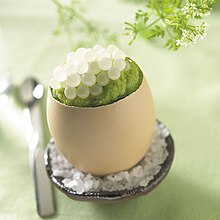Snail caviar
Screw caviar a is caviar alternative, from fresh or processed eggs of land snails , here typically from snails , is prepared. The names Escargot caviar or Escargot pearls are also used internationally.
The spherical eggs are naturally colorless to milky-white. After processing, the eggs appear cream-colored, pale pink or white and are usually 3–4 mm in diameter, possibly up to 6 mm. Some commercial snail farms offer snail caviar as an additional part of their product range.
Properties and use
The raw snail eggs have a smooth shell that is very delicate and easily broken. The eggshell consists of calcium , which hardens when exposed to air after the egg is laid. The shell protects the albumin , which is also covered by a thin, transparent membrane.
Snail caviar is often pasteurized to improve its shelf life . However, pasteurization changes the taste slightly. This is why snail caviar is offered without pasteurization, which has been preserved using brine as a preservative. Some manufacturers use flavored salt solutions to give the caviar a special taste.
The taste of snail caviar is different from conventional caviar. Often one finds the formulation, it tastes like forest or its taste is reminiscent of "baked asparagus" or "baked mushrooms" with a delicate woody note. Other consumers describe an "earthy" taste and find it crispier than fish caviar.
Like normal caviar, it can be served with toast, sour cream and champagne or as a soup.
Manufacturing
Commercial snail farming is a form of agricultural production also known as heliculture . It covers the entire process of rearing land snails specifically for human consumption, the result of which is primarily the snail meat.
The snail caviar is obtained with a lot of manual effort, which is why snail caviar is only processed and marketed in a few snail farms.
Snails lay their eggs once a year. Since snails are hermaphrodites , any snail can lay eggs. However, snails cannot fertilize themselves, they need a mating partner. About 10 days after mating, the snails lay up to 50 eggs in the ground.
To increase the yield, special rearing enclosures have therefore been developed, which promote maximum reproduction and reduce manual effort through optimal climatic conditions ( temperature , light and humidity). A common method for more effective egg harvesting is to put the mature snails in special boxes with earth and sand from which the eggs are collected.
economy
Profitable production of snail eggs is difficult when compared to the production of fish roe such as sturgeon : a snail typically lays around four grams of eggs per year, while a sturgeon can carry up to 18 kg of eggs.
As early as August 1987, snail caviar had a retail value of $ 1,400 per kg in the USA, which at that time was comparable to the retail price of beluga caviar . In December 2007, a 50 gram jar of De Jaeger snail caviar was sold on a snail farm in Soissons, France, for 80 euros (1,600 euros per kg). In January 2019, a 30-gram glass of snail caviar from Wiener Schnecken-Manufaktur in Vienna (Austria) was offered for more than 49 euros (1,633 euros per kg). A 50-gram serving is roughly equivalent to two tablespoons of snail caviar.
See also
Individual evidence
- ↑ Nichola Fletcher: Caviar: A Global History . Reaction Books, 2010, ISBN 978-1-86189-731-2 ( google.de [accessed January 30, 2019]).
- ↑ a b c Katy Winter: English snail farms are struggling to meet demands. In: DailyMail. October 9, 2013, accessed January 30, 2019 .
- ↑ Nataly Bleuel: The white pearls of France. In: Stern. July 10, 2014, accessed January 30, 2019 .
- ↑ a b c d e Günter Nietzke: The Roman snail . In: Prof. Dr. Reinhard Fangauf (Hrsg.): Ulmers animal book series . Eugen Ulmer, Stuttgart 1970, p. 123 .
- ↑ a b c d e f Jordane Bertrand: Snail caviar! The new gourmet frontier. Retrieved January 30, 2019 .
- ↑ Snails bring mice | RADIOdienst.pl. Accessed January 30, 2019 (German).
- ↑ Rachel Tepper Paley: What the Heck Is Snail Caviar? In: yahoo.com. Retrieved January 30, 2019 (American English).
- ↑ a b c d Helen Soteriou: Austria's only snail farmer. BBC News, September 3, 2014, accessed January 30, 2019 .
- ↑ Snail Caviar Slowly Catching On: Eggs From Garden-Variety Mollusks Fetch $ 40 to Ounce. In: Los Angeles Times. Retrieved January 21, 2015 .
- ↑ Viennese snail caviar. In: Viennese snails from Gugumuck. Accessed January 30, 2019 (German).

